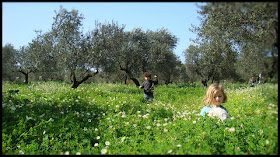 H, Uncle W. and cousin O. in the olive grove, chewing on lemon grass
H, Uncle W. and cousin O. in the olive grove, chewing on lemon grassAnd so what could be more idyllic than spending your Sunday afternoon on a checkered blanket in an olive grove up North, with a little picnic basket, some Kefraya blanc de blanc, and a couple of kids with a soccer ball? It was a massive olive grove with literally hundreds and hundreds of trees. And all around us, on the hills, there were more olive groves. And thus, a (semi-informative) post to celebrate Lebanese olive (oil).

The grass and wild flowers were thigh high
Not just the north of Lebanon is olive country. There are olive groves all over the south as well.
We like our olives.
There are an estimated 13 million olive trees in Lebanon, covering around 57,000 hectares. ‘This represented 20% of the total cultivated area in the country. (. . . ) The regional distribution of olive groves in Lebanon is 40% in the North, 39% in the South, 15% in Mount Lebanon, and around 6% in the Bekaa Valley.’ (Source)
You wonder with so many olive groves what we do with all those olives? Lebanon produces between 30,000 metric tons of olives (low yield) to a production high of 190,000 metric tons (in 2000).
Climbing the olive trees
Apparently we consume them all ourselves. I read here that a Western agricultural expert had commented that the agricultural sector of Lebanon was ‘export averse’, i.e. . not really looking to export.
The northern groves produce different olives that the southern ones. Little did I know, but it seems a ‘connaisseur’ can pick out the region (not the grove).
Descriptions of Regional Lebanese Olive Oils (source)
Whatever the type of the local olive variety, Lebanese olive oils are typically characterized by a mild aroma that is perceived as intense, but mellow once it enters the mouth sometimes with a peppery finish. Taste descriptions of selected typical olive growing areas in Lebanon are :
Batroun (Northern Lebanon, hilly, beautiful serene mountain region): Rich and fruity with a zesty flavor.
Koura (Northern Lebanon, coastal, with plains and hills): The four season climate and low soil acidity create a light and delicately flavored oil ideal for use in cooking.
Zgharta (Northern Lebanon, hilly with intermediate elevations): Fruity and fragrant with a subtle aroma.
Akkar (extreme Northern Lebanon, hilly with intermediate elevations): Rich with a distinct flavor of tomatoes and a strong spicy finish.
Rachaya el Foukhar (South East Lebanon, hilly with intermediate elevations): Mildly sweet with a herbal and floral aroma, oils from this region often have a distinct peppery flavor.
Hasbaya (South East Lebanon, steep hills and terraces): A rich taste and smoothly textured oil, moderately sweet with a pleasant herbal aroma.

The olive trees we were climbing and lounging in between were the Batroun version. We didn’t taste them though; the olive harvest does not start until November. We had the Rashaya version with us.
For more information on the Lebanese olive oil, check out this.

And we eat Lebanese olive oil in Canada :)
ReplyDeleteThis dog, it doesn't like lemon grass and you need to carry it even when there is no snow?
ReplyDeleteIf you haven't been to Bechealeh you should. They have olive trees that date back to 4000 B.C. (34.201700°N, 35.822800°E)
ReplyDelete...4000BC hahahaha
ReplyDeletevery funny M.Mathius!
...4000BC hahahaha
ReplyDeletevery funny M.Mathius!
Anonymous,
ReplyDeleteOlive trees are known and scientifically proven to last thousands of years.
More info can be found here: http://en.wikipedia.org/wiki/Olive#Old_olive_trees